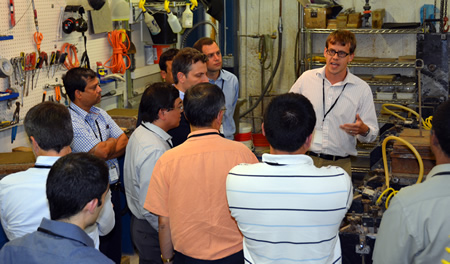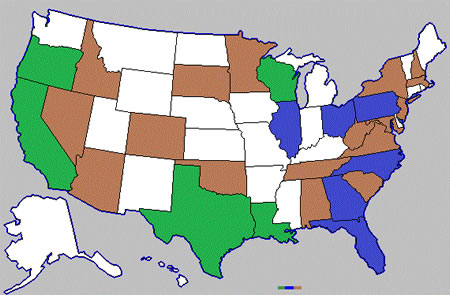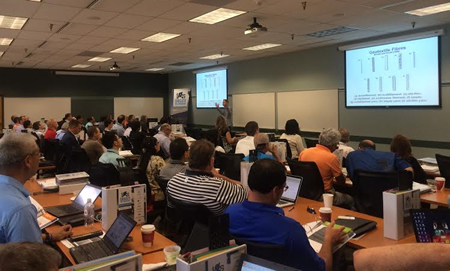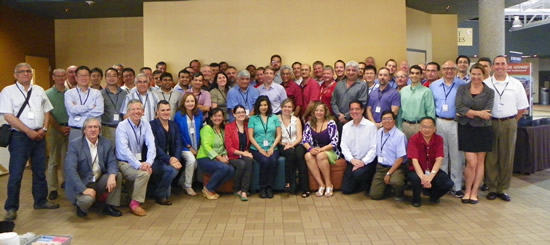[metaslider id=47714]
More than 40 civil and geotechnical engineering professors from across the US and Canada gathered in Austin, Texas in late July to take part in the Educate the Educators™ (EtE) event. Following the mission of the original EtE from the 1990s, the International Geosynthetics Society‘s (IGS) two-day program in Austin sought to increase geosynthetics education in university engineering curricula. The emphasis was on influencing undergraduate curricula so that all undergraduate engineering students have exposure to at least one 50-minute class on geosynthetics and geosynthetic applications.
The North American Geosynthetics Society (NAGS) hosted the event and Minerva Technology, Resources, and Information (Minerva) managed it. The non-commercial program was led by Prof. Richard Brachman (Queen’s University, Canada), Prof. Jorge Zornberg (University of Texas – Austin), and field veteran consultant Barry Christopher.
In addition to the US and Canada-based professors taking part, the group welcomed five attendees from outside North America. Those participants represented Egypt, China and Chinese Taipei, Indonesia, Peru, and Italy. They came with the expectation that, through their IGS Chapters, they will develop EtE programs in their countries.
Industry support from both private companies and independent organizations was key to the success of EtE. The financial contributions were so strong that participants needed only to fund their travel to Austin. Their accommodations, in-town travel, and meals were otherwise covered by the event.

The attendees were also given a four-station tour of the Austin-based TRI Environmental geosynthetics and geotechnical testing laboratories. This enabled them to witness tests up close, applying the information from the presented lessons directly to how the field tests and ensures quality and suitability of geosynthetics. Stops in the tour included the friction tests, tensile tests, and the variations, rationale, and need for index, bench, and large-scale tests.
Participation in the EtE program was determined by need and opportunity. Applicants were selected based on the ability to influence civil and geotechnical engineering curricula. Familiarity with geosynthetics was also part of the criteria, as EtE sought to interact with active professors who did not already include geosynthetics in their teaching.
Top-tier sponsorship (Gold) was provided by Tencate Geosynthetics, the Geosynthetic Institute (GSI), and the Industrial Fabrics Association International (IFAI). Silver sponsorship was provided by the Erosion Control Technology Council (ECTC), GSE Environmental, HUESKER inc., Presto Geosystems, ThraceLinq, and TRI Environmental.
CORRECTING AN IMBALANCE

The focus of EtE in Austin was slightly different than when GSI with the assistance of Dr. David Elton created it in the early 1990s. Back then, EtE pushed to bring basic awareness of geosynthetics to the tens of thousands of engineers entering the field each year by educating the professors who guided them.
Today, however, with geosynthetics being fully incorporated in the field, the need is slightly different. Some universities have strong geosynthetic content, either as dedicated courses or as lectures and topics worked into multiple courses. It’s estimated that only about 45 engineering programs in North America teach geosynthetics. Many others entirely lack even the most basic geosynthetic information.
With geosynthetics required in certain areas of engineering (e.g., waste management, coal ash storage) and with major sectors like mining using a massive amount of geosynthetics (e.g., 40% of the annual production of geomembranes), it is imperative to give future engineers exposure before they enter the workforce.
The challenge to this is finding a way into the already densely packed course load in college engineering programs. There doesn’t seem to be any space left for more information.
In Austin, EtE took this head on, effectively showing how readily programs can expand their curricula without breaking their well-established, tightly planned formats. In addition to core information on applications, materials, and the practice with geosynthetics, EtE instructors presented entire lectures. These sessions demonstrated how the information can seamlessly fit into current engineering education.
INDUSTRY RECEPTION

“The lack of education on innovative materials such as geosynthetics in our universities has to be improved,” said John Henderson. “The success of Educate the Educators demonstrates that both academia and industry are committed to changing the current situation.”
Henderson, like many of industry supporters on hand, leant private industry and professional organization insight. In addition to his tenure with Tencate Geosynthetics, he has served as the Geosynthetic Materials Association’s (GMA) Executive Council Chairman and currently serves as a the President of the North American Geosynthetics Society (NAGS).
“We, as an industry, did a very good job of giving the attendees the information they want in the way they want it,” said GSE Environmental’s Boyd Ramsey, who helped spearhead the EtE program and served as an event moderator and timekeeper. “It was well-organized and full. It was very busy. I really do think they’ll go back and include this in their classes wherever they can.”
Ramsey is the Immediate Past Chair of GMA’s Executive Council, an IGS Council Member and a leader of the IGS’s Technical Committee on Barriers.
A BRIGHT FUTURE

The organizers and sponsors of EtE in Austin have provided strong reviews of the program. It certainly seems to have hit its mark, with 43 professors going back to programs that have lacked or were in great need of updating their geosynthetic content. That number of participation, 43, is significant. Those professors can nearly double the amount of engineering programs that incorporate geosynthetics into their curricula.
In addition to the core classes that were demonstrated at the event, the professors left with binders full of material samples which they may use in class to demonstrate the wide range of geosynthetics in engineering. The binders included geotextiles, geogrids, geomembranes, drainage geocomposites, geocells, and other materials, as well as their many variations in construction, polymers, and flexibility, etc.
The international observers have also reported strong interest with at least one of those countries already working towards an EtE event in 2016.
Educate the Educators may have been overdue, but the field of geosynthetics has advanced a lot in the intervening years. The timing for this gathering seems to have been right, drawing strong attendance, positive reception, exceptional industry support, and observers who are eager to bring the program to other world regions.
The next generation of engineers will be even better prepared.











